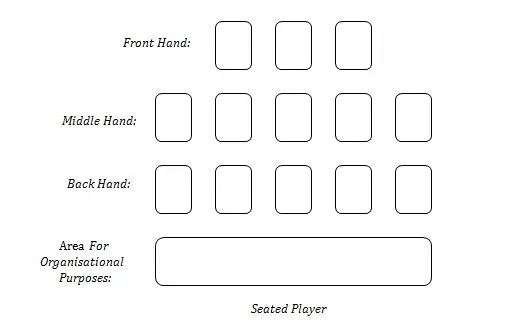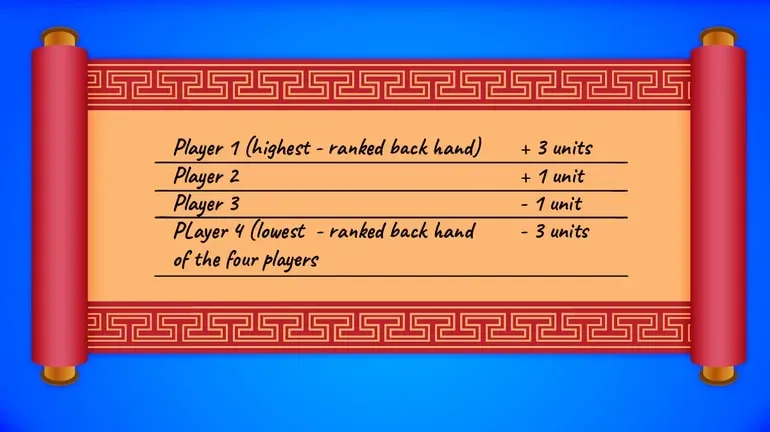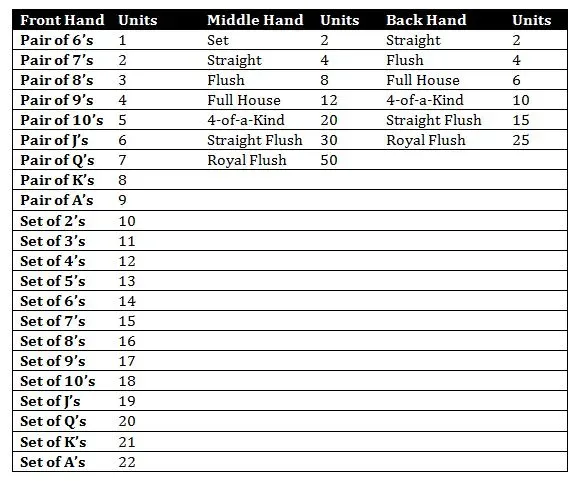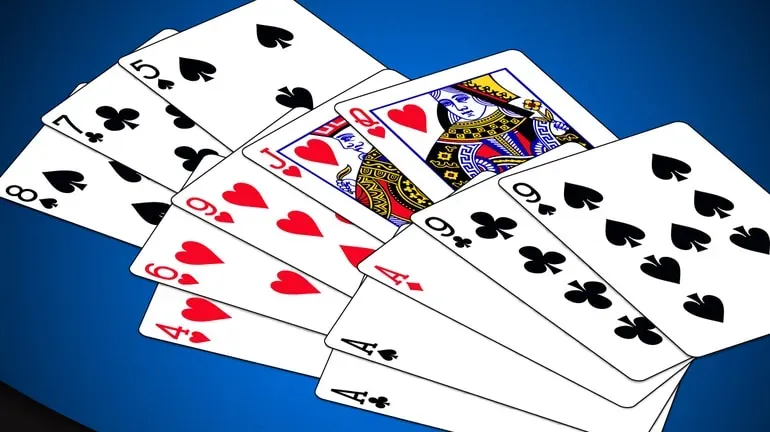Chinese Poker is a unique poker variant that doesn’t much resemble the other, more common forms of poker (like Hold’em, Omaha, or Stud), in terms of gameplay. However, as long as you’re familiar with the same poker hand rankings that are traditionally used, then you should be able to do just fine at this exciting twist of a game!
In brief, after receiving their 13 poker starting cards (yes, 13!), players must divide these cards into three different poker hands: 2 hands containing 5 cards and one hand containing 3 cards. Players attempt to make the best/highest-ranked holdings (compared to how other players have arranged their holdings) for each hand.
This game is quite exciting and fun, even for more inexperienced players, because of the amount of luck involved, and also, how you are in complete control of how you choose to arrange your cards into the different hands.
Therefore – to an extent – you’re able to determine your fate in this poker variant by figuring out the ideal order for how you should arrange your cards!
So, ultimately, you don’t need to be an experienced pro to do well in this game, but just ensure you know your poker hand rankings before you get going!
Table of Contents
- Chinese Poker Rules
- How to Play Chinese Poker (Gameplay)
- Chinese Poker Hands
- Chinese Poker Scoring
- Chinese Poker Points: Interesting Things to Note
- Chinese Poker Royalties
- Chinese Poker Game Variations
- Chinese Poker Strategy and Tips
- Chinese Poker Online
- Checklist: Things to Decide Upon Before Playing
- Chinese Poker Summary
Chinese Poker Rules
Because each player will be receiving 13 cards at the beginning of each round of gameplay, the maximum number is 4. This number is the most common format. However, gameplay between 2 or 3 people is entirely acceptable and permissible, too.
After players arrange their cards into different hand groups, players can either “surrender” (see definition below) or choose to play their hand. Then the remaining players reveal their holdings clockwise (starting to the left of the dealer), and then scoring commences. (More detail on how this works in the “Scoring” section later on.)
There are a few detailed notes on select rules and game options that should be addressed:
- Winning Outright: It should be noted that if any player makes three flushes or straights in their three hands, then they win the entire hand outright by default, regardless of the holdings of the other players, scooping 3 units from each player who hasn’t yet surrendered.
- Surrendering: This rule is optional (but usually played) that should be decided upon amongst players before gameplay begins. It’s where a player will pay a predetermined amount (usually somewhere between the amount they’d lose, if they lost 2-3 hands – so, for example, 2 to 2.5 “units”) and not end up playing their hand against the other opponents. Fortunately, though, they also do not pay royalties (discussed later), if there are any for that round.
- Mis-Set Hand/Foul: If a player places his cards in the wrong order (either by mixing up the middle and back holdings with regards hand strengths, or not having their 5-card hands be of higher value than their 3-card hand, etc.), then that player must pay each player equal to the amount as if they lost all three hands to all the other players. Note that someone who mis-sets their hand does not have to pay someone who had already surrendered. Players should decide beforehand if the mis-set player will still be required to play their hands as usual and score them accordingly, or if their hand will be forfeited and the penalty of paying 3 units to each player will suffice for the mis-set hand.
To help better illustrate the rules, let’s look at the following section regarding gameplay and how to play a hand of Chinese Poker.
How to Play Chinese Poker (Gameplay)
-
Dealing: The “dealer” (who rotates clockwise from one player to the next after each hand) deals 13 cards to each player, starting with the player to his immediate left.
- Setting: Each player arranges their cards into the three poker hands outlined above: two 5-card hands (“the middle” and “the back”) where they try to make the highest-ranking poker hands, and one 3-card poker hand (“the front”), where straights and flushes don’t count against said hand.
- NOTE: “The back” must be the highest-ranked hand of the three.
- NOTE: “The front”, even if it’s 3-of-a-kind, must still be placed in the front, and must ensure that the middle and back hands are of higher values than that 3-of-a-kind. Otherwise, penalties (as per the point on “Mis-Set Hand” in the above section of this article) could be incurred.
- Placing/Exposing Hands: Player’s then place their three hands systematically on the table, lined up face-down, one in front of the other. The back hand should be the hand closet to them (strongest-hand, 5 cards), followed by the middle in front of that, and the front (3 card-hand), lined up furthest away from the player. (See diagram below.)

- Are You Playing Your Hand? Players then announce in turn if they will play their hand, starting with the player to the left of the dealer. (This part is where a player would “surrender”, if applicable, as mentioned earlier.)
- Royalties: Players then announce their royalties in the same order. (More on this in the “Scoring” section.)
- Revealing of Hands: Players turn their cards face-up, exposing their front, middle, and back hands to the table.
- Scoring: This part is where winning hands are determined, and units/monies are exchanged/credited/tallied.
- Next Hand: After the hand concludes with all points being awarded, the dealer button moves one spot to the left, cards are shuffled, and the next hand begins.
Chinese Poker Hands
As mentioned, it’s crucial to know the standard poker hand rankings so that you can organize your hands appropriately from strongest to weakest.
Here’s a chart reminding you of the various hand rankings in poker, with examples of each:
- Royal Flush: 8-7-6-5-4 (all of the same suit)
- Straight Flush: 8-7-6-5-4 (all of the same suit)
- 4-of-a-Kind: A-4-4-4-4
- Full House (Boat): A-A-A-J-J (three of one, two of the other)
- Flush: A-J-8-4-2 (all of the same suit)
- Straight: 8-7-6-5-4 (of various suits)
- 3-of-a-Kind (Set/Trips): A-K-5-5-5
- Two Pair: A-A-J-J-2
- One Pair: A-A-7-4-2
- High Card: A-Q-9-6-3 (different suits, non-connected, unpaired)
To reiterate what was mentioned in the “Rule” section, it’s crucial to remember that if a player’s three hands are all straights or all flushes, then that player wins the entire hand by default!
Additionally, it should be noted in this section what the hand possibilities could be for the 3-card hand. Flushes and straights do not count, and they do not have enough cards to make too high-ranking hands.
Therefore, the 3-card hand can either make:
- Three-of-a-kind;
- One-pair (with a kicker); or
- A high-card hand.
Chinese Poker Scoring
Unlike blind or ante structures for stakes in other poker games, Chinese Poker uses something call units, which are predetermined monetary amounts that players agree on using before the game starts.
Therefore, as no poker chips need to be used like in other poker games, scores can be kept track of with a simple pen and paper, allowing players not to have to pay up after each hand and just be able to settle up with each other after their session concludes.

Regarding scoring and the winning/losing of units, every player collects one unit from each player whose hand they beat – and this process cycles through for the front, middle, and back hands, separately and respectively.
For example, suppose the following order for the *back* hand’s rankings. Beside each player is the number of units they will have either won or lost for this hand, followed by an explanation for how these numbers were arrived upon in the section below:
- Player 1 (highest-ranked back hand): + 3 units
- Player 2: + 1 unit
- Player 3: - 1 unit
- Player 4 (lowest-ranked back hand of the four players ): - 3 units
Awarding of Points
- Player 1 collects units from each of the players, as their back hand beats each of the other player’s back hands (+3 units overall).
- Player 2 gives one unit to Player 1 for having lost to him but collects units from Players 3 and 4 for beating their hands (+1 unit overall).
- Player 3 gives one unit each to Players 1 and 2 for losing to them but collects one unit from Player 4 for winning versus him (-1 unit overall).
- Player 4 gives one unit each to Players 1, 2, and 3 as he lost his back hand to all three other players (-3 units overall).
After this takes place for the back hand, the scoring process repeats separately for the middle and front hands, as well.
Bonus Points
There can also be scoring for additional “bonus” units awarded (decided upon beforehand) if a player wins a varying combination of multiple hands (front, middle, or back) during the same round of gameplay:
- In some versions of the game, players receive one extra unit from each player if they win 2 of the 3 hands.
- In other versions, this bonus unit is only awarded if a player wins all 3 hands.
There are two standard game methods, which award these “bonus” units. Be sure to decide and agree upon which you’d like to use (if any) before playing:
- 1–6 method: If (and only if) a player wins all three hands 3 bonus units are given from each other player to that winning player. However, no bonus points are awarded if a player only wins 2 of the 3 hands.
- 2-4 method: If a player wins the majority of hands (either 2 or 3 of them), then there is 1 “overall winner” bonus unit collected by this player from each of the other players.
Keeping Score More Easily
Especially with multiple players, the easiest way to keep score is to track everyone’s scores between each other player separately. Begin recording wins/losses starting with the player to the left of the dealer.
Compare his hands separately to each of the players to his left. Then continue with the player to the left of him. Compare hands to the remaining players who haven’t already been tallied, finishing with the last score being tracked between the dealer and the player 3 to his left (or immediate right), assuming there are 4 players.
A common ledger for one player’s score sheet might look something along the lines of this:
Player 1’s Scoreboard

With score sheets organised and set up like this, players can keep track more easily of how they are doing throughout the game (seeing if they’re up or down), and also settle up individually and with more ease with each player afterwards.
Chinese Poker Points: Interesting Things to Note
-
It should be noted how in this poker format, you can have the second-best hand and still win some money because your hand is still ahead of some of the other players. This setup is different from other forms of high-hand poker games that only have one winner (or player awarded money) each hand (except in the case of a split pot).
- As each hand is compared directly and individually to another specific player’s, you can have different values of units being awarded directly between select players, without the other players being affected. For example, one “unit” between two specific players could be worth $50, while every other unit awarded in the game is only worth $10. This aspect is another unique part of gameplay versus that of other traditional forms of poker.
Chinese Poker Royalties
You’ll notice in the 5th bullet point of the “Gameplay” section was the mention of royalties. These are bonuses awarded to players if they have particularly strong holdings.
While the exact number of units for each royalty can be altered and/or should be decided upon exactly before (use the charts below as a baseline to draw from), there are two types of royalties that may be awarded in the game of Chinese Poker:
- Hand-Ranking Royalties (where royalties of set, predetermined amounts are awarded based on select hand rankings and where that hand is located - front, middle, or back).

- Naturals (which is a special type of royalty awarded that is based upon all 13 cards falling into a select “special hand” category – see below). It should be noted that naturals are awarded before anyone can surrender, and also that the player will not play their hand. They’ll just be awarded the corresponding bonus points. Play can continue for the hand between remaining players, if desired.
- Hand – 3 units
- Six Pairs – 3 units
- Three Straights – 3 units
- Three Flushes – 3 units
- No Broadway Cards* – 3 units
- Dragon (13 different cards), Ace thru King – 13 units
*optional
Sometimes, royalties are given to any player who has a hand that qualifies. Other times, royalties are only awarded to the player who has the better royalty in that specific hand.
For example, if one player had a straight flush in their back hand and another player had a royal flush in their back hand, the royalty then would only be awarded to the player who had the royal flush.
Chinese Poker Game Variations
There are two main variations to the game of Chinese Poker, and those are Open-Faced Chinese Poker and a game called Pineapple. Both even include a legendary element to the game called “Fantasy Land”! Even after these main types, though, there are still a few other lesser-played game variations for this form up poker.
In this section, the aim to elaborate on these different twists:
- Open-Faced: In Open-Faced Chinese Poker, the general concept of the game is the same, but how a player’s cards are ultimately played into the three different hands is quite a bit different! Here, players start with only 5 of their ultimate 13 cards, and (beginning with the player to the left of the dealer) place these 5 cards face-up to start forming their three different hands. Note that once these cards (and subsequent cards, too) have been placed in their rows accordingly, they cannot be moved!
After this initial round, players each draw one more card at a time and then add it into one of their face-up hands on the table. This process continues until a player has received and played all 13 cards in their hand.
Even though they don’t know their ultimate 13 cards right away, players can still foul (or mis-set) if they misplace the correctly ranked order of their three hands by the end, forfeiting all bonuses/royalties they may be due. (This scenario is much more common in Open-Face than in Classic Chinese Poker.) It’s commonly accepted in Open-Face that if you foul, you must pay six units to each opponent who doesn’t also foul. Additionally, surrendering forfeits you two units to each opponent who doesn’t surrender. However, as per usual, these are units that can ultimately be altered/decided upon before gameplay.
Regarding scoring, it happens just like in regular Chinese Poker, with players winning one unit from their opponent(s) for each hand of theirs that they beat. The 1-6 method is generally used in Open-Face, meaning that only if you sweep and win all three hands, each player gives you an additional 3 units as an award.
Royalties are a bit different in Chinese Poker because one doesn’t know their entire hand from the get-go. Therefore, it’s a lot less likely that one of the royalties will be achieved (specifically the hand-ranking royalties), meaning the awards for these should be much higher than regular Chinese Poker.
The following chart is a recommended baseline to go by for unit amounts for royalties in Open-Faced. Again, the exact number of units can change, as per whatever players agree upon beforehand:

As royalties cannot be announced before completion of setting/placing a hand (as all the cards will not have yet been drawn), royalties are calculated and tallied during the scoring of each hand.
Fantasy Land: This addition to the game is an optional (but commonly used) in Open-Face whereby if players make a pair of Queens or better in their front hand without fouling, they enter Fantasy Land. Once here, they receive a massive advantage for the next hand, being dealt all 13 cards for their hand at once, exposing them to the table, only once setting is completed by other players. To stay in Fantasy Land for the next hand, players must then make any one of the following:
- Trips in their front hand;
- A full house (or better) in their middle hand; or
- Quads (or better) in their back hand.
- Pineapple: This variant is quite similar to Open-Faced Chinese Poker, but the dealing is done differently after the initial 5 cards are placed. Instead of receiving and placing one card at a time after these first 5, players receive 3 cards on each turn thereafter and must play 2 into their tabled hands and discard the other card face-down. (Note that, as other players won’t see this discarded card, it can be highly advantageous to discard the card(s) you know that your opponent is looking for!)
Because of how the drawing works with gameplay, there are only 5 turns total between players in this variant (speeding up gameplay). Also, only a maximum of 3 players total, that can play, because of the cards that will make up the discard pile. As per usual, Open-Faced Chinese Poker, Fantasy Land rules and requirements stay the same. However, in Pineapple’s Fantasy Land, players receive 14 cards and discard one of them face-down, in setting and arranging their ultimate hand.
- 7-2 Lowball: In this variant, the middle hand is played as a 2-7 low hand.
- Criss Cross: This format is a heads-up (2-player) twist on the classic version of Chinese Poker. Here, players are each dealt 2 hands of 13 cards, and each hand goes head-to-head with the corresponding one across the table. It should be mentioned that players cannot exchange cards between their two originally dealt 13 card hands! Ultimately, this variant helps promote a slight increase to speed of gameplay, allowing players to play more hands in a shorter amount of time (without having to shuffle and re-deal in between each individual/singular hand).
- The Wheel Straight: Here, the wheel straight of A-2-3-4-5 is considered the next best straight after A-K-Q-J-T.
Therefore, in terms of rankings of straights, it would go something like this:
- A-K-Q-J-T
- A-2-3-4-5
- K-Q-J-T-9
- Etc.
Chinese Poker Strategy and Tips

-
Be Sure Not to Foul: Especially in the classic version of Chinese Poker, fouling (or “mis-setting” as we previously put it) is a stupid mistake that can cost you a lost and add up big time. Put your cards in the right places and be sure not to mess this up!
- Note Your Opponents’ Face-Up Cards (In Open-Face): Being able to see the other cards on the table can help you determine which cards are still left in the deck, and what the likelihood is that you might get that certain card that you need to make your hand. Pay attention to those removed cards so that you can better calculate your outs and odds accordingly.
- Don’t Treat Your Front Hand Like a Discard Pile: The front hand still makes up 33% of the total points you’re going to score (win or lose) each round. Therefore, don’t just try to make strong hands in the back and middle hands, giving up unnecessarily on the smallest hand of the three. It still carries great importance and can help shift your losing sessions into winning ones, if you keep focusing on how you can arrange your cards the best all-around, including your front hand.
- Play Small Stakes: Because of the variance and swings associated with Chinese Poker, play smaller stakes than you might *think* that you’d feel comfortable with playing. Especially when accounting for the possibilities of royalties; imagine if someone binks that royal flush and how much money you could be out, regardless of how well or brilliantly you play or arrange your own hands from round to round! Yes, the same could be true on the flip side, too, but even with that said, just be aware: Chinese Poker is a game of high variance and shouldn’t be played with stakes too high and/or money that you can’t afford to lose.
- Factor In Any Noticeable Opponent’s Tendencies Into Your Overall Strategy: This tip applies more for Open-Face and Pineapple, as you can see your opponent’s cards, and also, there are multiple rounds of drawing and setting/placing. As a prime example of what you could factor into your hand setting decision-making, if you see any risk-loving opponent. A player who’s always gunning to try and make that more-often-unlikely-than-likely-to-make-hand, then play things safe yourself! Don’t go for anything overly ambitious in your hands, and let your opponent burn themselves into oblivion by either fouling or never being able to make decently strong hands themselves because they’re always gunning for unreasonably high-ranked hands.
Chinese Poker Online
While certainly not as popular as Hold’em or Omaha, Chinese Poker still has its devoted fan base. It can be played on select sites online, typically seeing it played between 3-4 players.
As a practice tool, you can use a free website called Primedope, where you can be dealt 13 cards, arrange them yourself, and then be shown an analysis of optimal ways you may have chosen to organize your cards instead.
Checklist: Things to Decide Upon Before Playing
As you’ve likely noticed in this article, there are many variations and optional rules that can be used during the gameplay of Chinese Poker. The purpose of this section is to help consolidate down these key points into an easy-to-answer section that will help clarify all optional/variating rules before you begin, so there’s no ambiguity between players.
- Which method of awarding “bonus units” are you using? The 1-6 method (win all hands, 3 bonus points) or the 2-4 method (win majority of hands, 1 bonus point)?
- What is the exact amount a player who surrenders will have to pay?
- If a player mis-sets their hand, do they still play it (after paying the penalty) as normal, subsequently including them in the scoring for that round?
- Are any players using different values of units between them specifically?
- Do you want to play with the optional “No Broadway Cards” naturals royalty, too?
- What are the point values for each royalty? Do you want to vary the award amounts from those mentioned in this article or nix the use of certain royalties altogether (perhaps some of the naturals)? Do you want only the player who has the best royalty of the hand to be awarded, or for all players who have a qualifying royalty hand to benefit?
- Do you want to play with Fantasy Land, if you’re playing the Open-Faced or Pineapple variant?
Chinese Poker Summary
In closing, Chinese Poker is a fascinating game for poker lovers and thrill-seekers alike! Being able to collect royalties, get bonuses, beat your friends and have varied stakes in the same game between different players.
You can still win money for having the second-best hand in a round and being able to control your fate (to some extent) by how you choose to arrange your hands.
This game has a little bit of everything (and IS undoubtedly a LOT of fun) if you enjoy playing poker!


